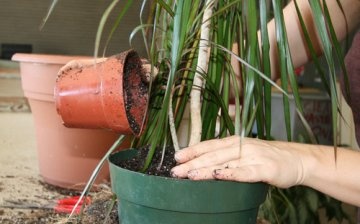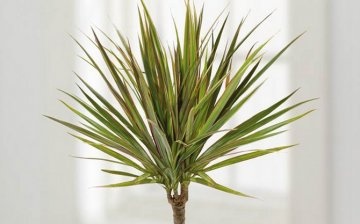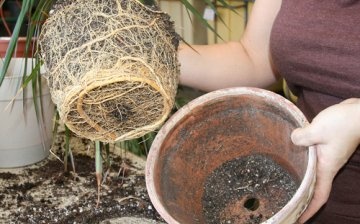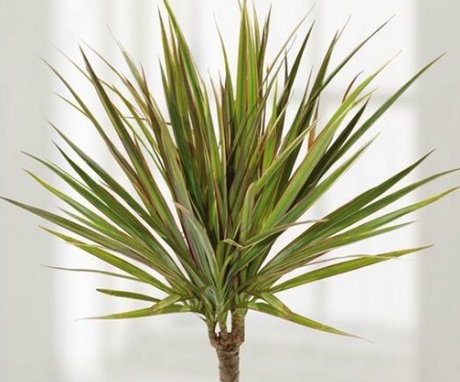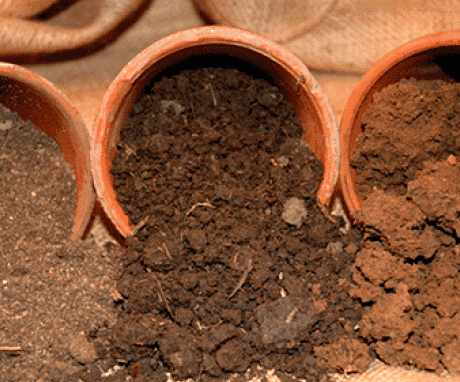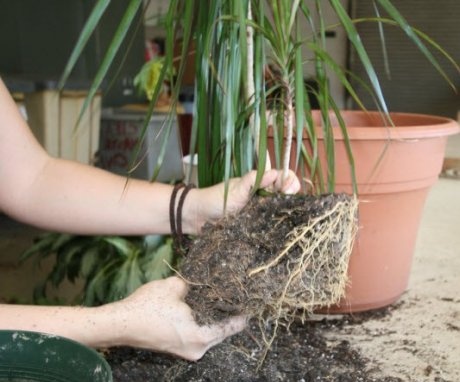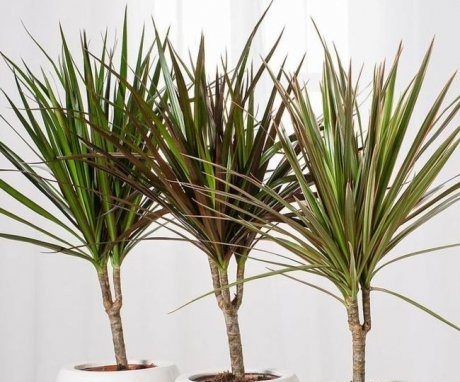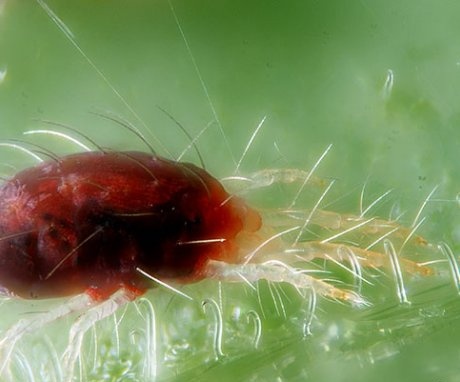Dracaena transplant: rules and terms
Dracaena Is a popular tropical plant of the Asparagus family. There are more than fifty species. We grow dracaena as a houseplant. It needs to be transplanted periodically. What is the best way to do this?
Content:
- Dracaena: description
- Preparing dishes and soil
- Dracaena transplant
- Transplant after purchase
- Dracaena care after transplant
- Dracaena pests
Dracaena: description
Many kinds dracaena look like a palm tree with a bare trunk and a shock of narrow long leaves. Some specimens reach a height of 3 m in a room. They can grow for 5-15 years.
Dracaena types:
- Marginata (Bordered) is a large plant that can grow in a room up to 3 m. Its narrow lower leaves periodically fall off, leaving a beautiful pattern on the trunk. Bunches of leaves remain only at the top.
- Deremskaya has large leaves with white longitudinal stripes.
- Dracaena Sander looks a bit like bamboo. The leaves have yellow stripes.
- Fragrant is prized for its beautiful white flowers that emit a pleasant aroma. The leaves are elongated, with light stripes. Withstands frost up to 10 degrees.
- Bent down is called so because of the shape of the leaves directed downward. The root begins to branch from below, the leaves have a yellow border.
- Dracaena Godsef differs in appearance from other dracaena. She has oval bright leaves with yellow and cream spots.
- Dracaena Draco grows up to 1.5 m. In appearance it resembles a palm tree. Leaves with a reddish-brown border.
With good care, the dracaena grows rather quickly, increasing in size. The question of plant transplantation arises.
Preparing dishes and soil
It is better to replant the dracaena in the spring, in March or April. Young specimens every year, older plants in 1-2 years. Some growers advise replanting in the fall, before the plant plunges into a dormant state. It is better not to disturb him in winter.
The well-being of the dracaena largely depends on which pot it is planted in. It should not be small, because the roots will not fit in it, and the amount of soil will not be enough to provide food for the flower. A plant with a height of 45 cm corresponds to a pot with a diameter of 15 cm. It is impossible to buy a pot that is too large in the expectation that the plant will grow. In a large pot, water will stagnate, leading to the death of the plant. It is especially dangerous if excessive moisture is combined with a sharp drop in air.
Each new pot should be 3 cm larger than the previous one.
The material doesn't really matter. It can be ceramic or plastic. The shape is most often chosen in the form of a glass. There should be large holes at the bottom to drain excess water. Before planting, the pot is scalded with boiling water.
Prepare the soil or buy in the store the soil for dracaena or palm trees... Dracaena roots love air. To cook it yourself, mix on a piece of leafy earth and compost, add 2 parts of turf and half of peat and sand. The younger the plant, the finer the sand you need to take. If an adult dracaena is transplanted, a fourth of the pot is poured into sand. Soil acidity up to 6.5 pH. It is not advised to take land from a garden or vegetable garden due to the fact that it is too nutritious and contains a lot of mineral salts.It is not necessary to take the peat itself, because it is very heavy. You can add coco soil to it.
Drainage is essential for successful transplantation and subsequent growth. It can be gravel, expanded clay, broken pots. The thickness of the drainage layer is at least 3 cm. If the holes are large, the thickness of the drainage may be less.
Dracaena transplant
Houseplant transplant rules:
- Water the plant so that the earth becomes soft and easily lags behind the walls of the pot. Carefully take out the dracaena, shake off the old earth.
- If there are damaged or rotten roots, remove them with a sharp knife. Spray the root system with a spray bottle.
- Immerse the plant in a cooked dish. Before this, the place of transition of the trunk to the root collar is determined. It cannot be immersed deeply in the soil. Lightly sprinkle the neck with earth.
- Fill free areas with prepared soil.
- Watered immediately after transplantation with Zircon solution. It will help the dracaena to survive the stress in which it will be for 2 weeks, and to grow new roots.
Caring for the transplanted dracaena consists of regular watering with the addition of Zircon 2 times a month. The plant is fed with fertilizers for palm. In summer, watering is carried out 2 times a week, in winter once is enough. The concentration of the solution is reduced by 2 times.
Transplant after purchase
When buying a dracaena, you need to ask the seller where it came from. Many foreign firms sell dracaena in a special substrate for transportation. In this case, it is imperative to transplant the flower. The substrate is shaken off, replacing it with soil intended for dracaena. Plants are transplanted in the same way, the appearance of which raises concerns for their condition.
Young plants that look healthy and develop well are not worth replanting. If you decide to transplant, they transfer a lump of earth into a new pot without shaking out the earth. So the roots of dracaena are practically not injured.
Dracaena care after transplant
The amount of light that dracaena requires is directly related to the color of the leaves. The brighter the leaves, the more light the flower needs. If it is not enough in the room, they supplement it phytolamps... Otherwise, the plant will stretch towards the light, and the color of the leaves will become pale. It is necessary to carefully expose the dracaena on the southern and southwestern windowsill.
The bright rays of the sun can burn the leaves.
In this case, they turn brown and fall off. To prevent this from happening, the plant is shaded. The temperature in the room where the dracaena is grown is kept within 24 ° C in summer, lowered in winter, but it should not fall below 15 ° C. Dracaena does not like drafts, so it is better to put it away from an open window. Can be taken out into fresh air.
Correct watering:
- Dracaena easily tolerates the drying out of an earthen coma, but reacts well to watering with warm water. In the summer they water it 2 times a week, in the winter it is enough times.
- It is advised to dip the pot in a bath of water once a month. But you should not overmoisten the plant. With excessive watering, the dracaena sheds its leaves, and the root system can rot.
- Dracaena loves high humidity air. If it is too dry, the tips of the leaves dry out. Spraying is carried out periodically.
- Dracaena reacts well to shower... After it, he becomes fresher and looks well-groomed. They make sure that the water does not fall into the axils of the leaves and does not stagnate there. If you cannot spray the leaves, you can wipe them with a damp sponge.
Dracaena pests
The main pests and control of them:
- Dracaena thrips. These are light brown insects up to 1.2 mm in body length. They and their larvae suck sap from plant cells. This is manifested in small strokes, which eventually merge into light spots. Over time, the damaged tissue dies off, resulting in holes in the leaves. Leaves fade, wither, fall off. Thrips carry various diseases.They move easily from one plant to another. Thrips or their wingless larvae can be seen on the underside of the leaf. The pot with the affected dracaena is carefully transferred to an isolated place so as not to shake off the insects. If they fall to the surface, they can move to another flower or wait for the return of the dracaena.
- Shields have a size from 0.5 to 5 mm. Their body is covered with wax shields. They infect leaves from below and from above, especially young shoots. As a result of their activity, a sticky liquid forms on the leaves. Yellow spots appear on them. Leaves fall. It complicates the access of air to the plant. Scabbards can be seen on the leaves or trunk at the bottom.
- A spider mite is manifested by the presence of a thin web along which it moves around the plant, and the appearance of brown specks on the leaves, as a result of which they turn yellow and fall off. The web can be dense and entwine a significant part of the leaf. Spider mites are light green in color with two dark spots. In winter, they hibernate. In doing so, their body becomes red in color. They begin to damage the lower leaves of the dracaena, then move to the upper ones. Damaged leaves turn yellow, spots appear on them. If spider mites are not dealt with, they can kill the plant. Hot and dry weather with a temperature of about 30 degrees promotes the reproduction of the tick.
The plant is treated with Fitoverm, Confidor, Intavir, Aktellik. If these funds are not available, you can wipe the leaves with a solution of laundry soap. But thrips cannot be destroyed in this way. This is only a temporary measure.
More information can be found in the video:



